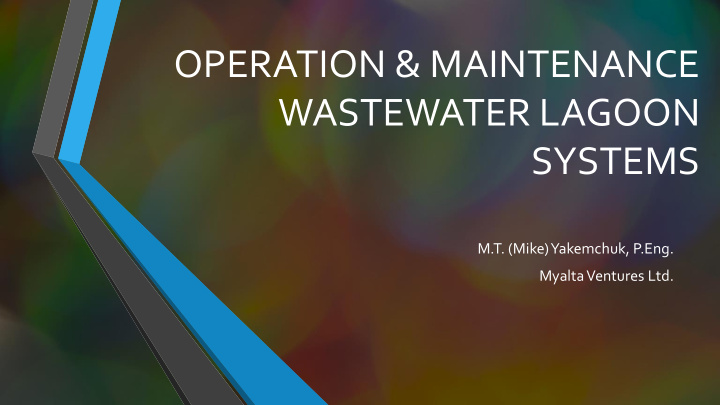



OPERATION & MAINTENANCE WASTEWATER LAGOON SYSTEMS M.T. (Mike) Yakemchuk, P.Eng. MyaltaVentures Ltd.
WASTEWATER LAGOON SYSTEMS • Provide secondary treatment of domestic wastewater by the action of bacteria stabilizing the organic matter in the wastewater. • Meets the treatment standard required by Federal and Provincial authorities • Withstands high flow and organic loading fluctuations • Less costly than mechanical WWTPs. • Less operator attention required than mechanical WWTPs. • Relatively easy to maintain. • Do require attention.
DISADVANTAGES of WASTEWATER LAGOONS • Algae in effluent • Less effective in removing Ammonia than other technologies • Pond turnover and other odour issues • Potential leakage concerns • Long-term solids accumulation • Larger foot-print required
TYPICAL LAGOON CONFIGURATION • ANAEROBIC CELLS (2 cells or 4 cells) – 3 days of detention time • FACULTATIVE CELL – 60 days of detention time • STORAGE CELL – current standard is 1 year of storage
ANAEROBIC CELLS • ADVANTAGES • Infrequent sludge removal • High degree of stabilization is possible • Low or no energy requirements • Ease of operation
ANAEROBIC CELLS • DISADVANTAGES • Incomplete BOD5 removal • Odours • Processes are sensitive to temperature
FACULTATIVE CELL • Facultative cell is relatively shallow (2 meters), open to the sun and air • Three layers of treatment in the cell: • Aerobic bacteria • Facultative bacteria • Anerobic bacteria • Each decompose organic matter in three different zones
AEROBIC ZONE • Bacteria uses dissolved oxygen to decompose organic waste by oxidation • Oxygen comes from wind action and photosynthesis • Algae reacts with sunlight to produce new cells, releasing oxygen as a by-product
FACULTATIVE ZONE • At a depth of 600 mm, sunlight penertration is reduced in the cell and dissolved oxygen levels are lower. • Facultative bacteria can decompose organic matter under these lower oxygen levels
ANAEROBIC ZONE • Wastewater solids, bacteria, and algae settle on the bottom of the cell and form a sludge layer • Anaerobic digestion occurs where the bacteria converts organic matter into different volatile organic acids
STORAGE CELL • As the name implies, cell contains the wastewater for a predetermined period time, usually one year • Key element of storage cell is ability to hold liquid • Clay liner must utilize a clay that demonstrates the ability to retain water • Synthetic liners are usually HDPE geomembranes
MAINTENANCE of WASTEWATER LAGOON SYSTEM • Regular monitoring of influent and inter-cell flow (weekly) • Remove duckweed and scum – facultative cell • Cut grass, weeds, and shrubs along the berm • Control cattails • Maintain fence surrounding lagoon • Control rodents and other animals
BIOCHEMICAL OXYGEN DEMAND (BOD) • Measures the organic strength in the wastewater • 5 day BOD test measures the amount of oxygen required in a five day period by the micro-organisms need to consume the organic matter in wastewater • Normal domestic wastewater varies between 150 – 250 mg/L BOD • Effluent standard is less than 25 mg/L
SUSPENDED SOLIDS (SS) • Suspended solids removal is a important as BOD removal for preventing receiving stream pollution • Normal domestic wastewater has similar SS and BOD levels (150 – 250 mg/L) • Effluent standard is less than 25 mg/L • SS are difficult to remove from lagoon effluents due to the high concentration of algae in late summer and fall discharges
QUESTIONS? Mike Yakemchuk myalta@shaw.ca
Recommend
More recommend